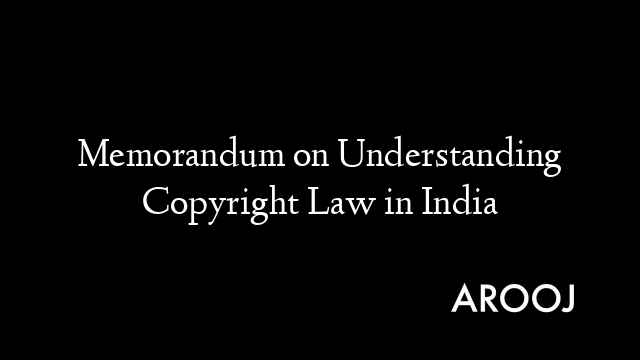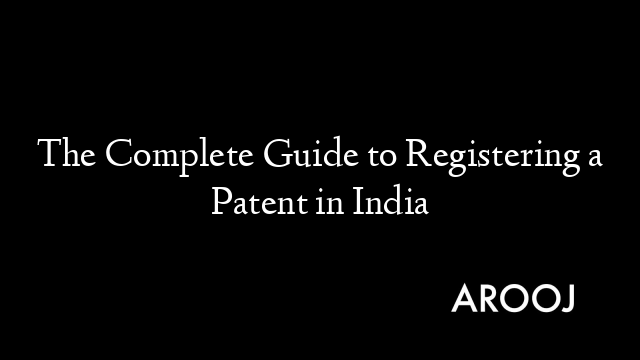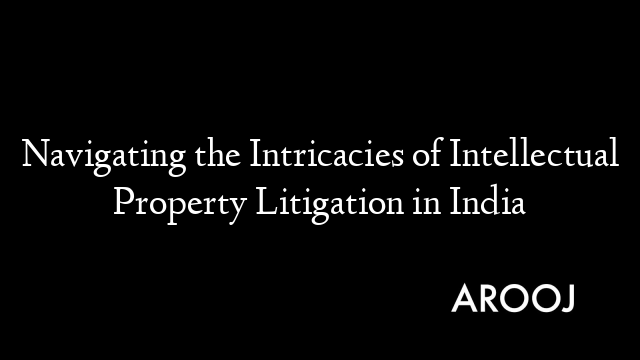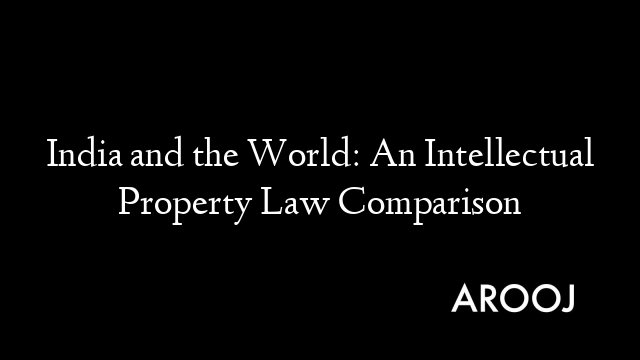Contents
- 1 I. Introduction
- 2 II. Understanding Intellectual Property Rights (IPR) in India
- 3 III. Licensing Intellectual Property in India
- 4 IV. Strategic Considerations in Licensing IP
- 5 V. Legal and Regulatory Considerations
- 6 VI. Practical Steps for Effective IP Licensing
- 7 VII. Case Studies
- 8 VIII. Final Thoughts
- 9 IX. Appendices
I. Introduction
In the modern economy, intellectual property (IP) stands as a pivotal asset for businesses, driving innovation, competitiveness, and growth. The dynamic landscape of globalization, coupled with rapid technological advancements, has magnified the significance of intellectual property rights (IPR) as a central pillar in fostering creativity and entrepreneurship. As businesses increasingly recognize the value locked within their intangible assets, the strategic management of IP through licensing emerges as a crucial pathway to unlocking this value, fostering innovation ecosystems, and propelling economic growth. This memorandum is dedicated to elucidating the nuanced landscape of IP licensing within the vibrant and diverse context of India, a burgeoning hub of innovation and creativity.
A. Purpose of the Memorandum
The primary purpose of this memorandum is to serve as a comprehensive guide for entities looking to navigate the complexities of intellectual property licensing in India. It aims to provide an in-depth analysis of the legal frameworks, strategic considerations, and practical steps necessary for effectively licensing IP in one of the world’s fastest-growing economies. Whether you are a startup seeking to commercialize innovative technology, a multinational corporation looking to expand your intellectual property portfolio, or an academic institution aiming to translate research into societal benefits, this memorandum offers valuable insights into leveraging IP assets through strategic licensing agreements.
B. Overview of Intellectual Property Licensing
Intellectual Property Licensing is a contractual arrangement wherein the owner of an IP (licensor) grants permission to another party (licensee) to use the IP under defined conditions, without transferring the ownership of the IP. This arrangement enables IP owners to monetize their assets while allowing licensees to access, utilize, or commercialize a patented invention, trademark, copyrighted work, or design that they do not own. Licensing agreements can vary widely in terms of scope, duration, territory, and financial arrangements, reflecting the unique needs and strategies of the parties involved.
At its core, IP licensing is a tool for risk management, revenue generation, and strategic collaboration. It facilitates the diffusion of technology and creative works, thereby stimulating further innovation and contributing to economic development. For licensors, it can provide an essential stream of income and a way to enhance the market adoption of their innovations. For licensees, licensing agreements offer a means to acquire essential technologies, brand names, or creative content necessary for their business operations, product development, and competitive positioning.
C. Importance of IP Licensing in India
India’s economic landscape is characterized by a robust growth trajectory, a diverse industrial base, and a flourishing startup ecosystem. With its vast pool of talented innovators, scientists, engineers, and entrepreneurs, India presents immense opportunities for the creation and commercialization of intellectual property. The importance of IP licensing in India cannot be overstated as it plays a critical role in:
- Fostering innovation and creativity across various sectors.
- Enabling technology transfer and diffusion, which are vital for the country’s industrial and technological development.
- Attracting foreign direct investment (FDI) by providing a secure and predictable legal framework for IP transactions.
- Supporting the growth of startups and SMEs by enabling them to leverage IP for business expansion and collaboration.
- Strengthening the global competitiveness of Indian businesses through the strategic use of IP assets.
D. Scope of the Memorandum
This memorandum aims to provide a holistic view of the IP licensing landscape in India, covering legal, strategic, and practical dimensions. It is structured to address the needs of a diverse audience, including IP owners, potential licensees, legal practitioners, policymakers, and academics. The scope encompasses:
- An overview of the types of intellectual property and their legal protections in India.
- Detailed guidance on negotiating and drafting IP license agreements, including key terms and conditions to consider.
- Strategic considerations for licensors and licensees, including IP valuation, risk mitigation, and enforcement.
- A review of legal and regulatory considerations, including compliance with Indian laws, antitrust issues, and tax implications.
- Practical steps for executing effective IP licensing strategies, from conducting IP audits to managing licensed IP.
By providing insights into the strategic use of IP licensing as a tool for innovation and economic growth, this memorandum seeks to empower stakeholders to navigate the complexities of IP management in India’s dynamic market.
II. Understanding Intellectual Property Rights (IPR) in India
India’s framework for intellectual property rights (IPR) is extensive and designed to protect and promote innovation and creativity across various sectors. The understanding of IPR types and the legal framework in India is foundational for anyone looking to engage in IP licensing within this vibrant market.
A. Types of Intellectual Property
1. Patents
A patent is a right granted to an inventor for a limited period, usually 20 years, allowing them the exclusive right to make, use, sell, and distribute their invention. In India, patents are awarded to inventions that meet three key criteria: novelty, inventive step (non-obviousness), and industrial applicability. The process involves a detailed examination of the patent application by the Indian Patent Office to ensure that it meets these criteria.
2. Trademarks
Trademarks are distinctive signs or symbols used by a business to identify its products or services and differentiate them from those of others. Trademarks can be names, logos, slogans, sounds, colors, or a combination thereof. In India, trademarks are registered under the Trademarks Act, 1999, which provides the trademark owner with the exclusive right to use the mark and to prevent others from using a deceptively similar mark on related goods and services.
3. Copyrights
Copyright protects original works of authorship, including literary, dramatic, musical, artistic works, and certain other intellectual works. In India, copyright protection is automatic upon creation of the work and does not require registration, although registration provides a prima facie evidence of ownership. The Copyright Act, 1957, grants the copyright owner exclusive rights to reproduce the work, communicate it to the public, and make derivative works, among other rights, for the lifetime of the author plus sixty years after their death.
4. Trade Secrets
Trade secrets consist of practices, designs, formulas, processes, or any information that has independent economic value by not being generally known or readily ascertainable. While there is no specific legislation for trade secrets in India, they are protected under the common law principles of confidentiality and contractual agreements between parties.
5. Industrial Designs
An industrial design refers to the aesthetic or ornamental aspect of an article, which may consist of three-dimensional features, such as the shape or surface of an article, or two-dimensional features, like patterns, lines, or color. The Designs Act, 2000, protects designs in India, ensuring the owner has the exclusive right to use the design and to prevent its unauthorized copying or imitation by others for a period of fifteen years.
B. The Indian Legal Framework for IP
1. The Patents Act, 1970
The Patents Act, 1970, as amended, governs the process of patent application, examination, grant, and enforcement in India. It provides a detailed mechanism for the protection of inventions across all fields of technology, ensuring that inventors can commercially exploit their inventions while also contributing to the public domain post-patent expiration.
2. The Trademarks Act, 1999
This Act consolidates the laws relating to trademarks, aiming to provide for registration and better protection of trademarks for goods and services and prevent their misuse. The Act is fully compliant with the TRIPS (Trade-Related Aspects of Intellectual Property Rights) Agreement, ensuring that India’s trademark laws meet international standards.
3. The Copyright Act, 1957
The Copyright Act, 1957, provides protection for a wide range of creative works, including literary, musical, artistic works, and cinematograph films and sound recordings. It has been amended several times to comply with international treaties, including the Berne Convention for the Protection of Literary and Artistic Works and the World Intellectual Property Organization Copyright Treaty.
4. The Designs Act, 2000
The Designs Act, 2000, is aimed at protecting the visual design of objects that are not purely utilitarian. It covers features of shape, configuration, pattern, ornament, or composition of lines or colors applied to any article, whether in two or three dimensions.
5. Relevant Provisions for Trade Secrets and Confidential Information
In the absence of specific legislation, trade secrets and confidential information are protected under the Indian Contract Act, 1872, and the Information Technology Act, 2000, which provide for the protection of data and prevention of breach of confidentiality agreements.
C. Regulatory Bodies
1. Indian Patent Office
The Indian Patent Office, under the Department of Industrial Policy & Promotion, Ministry of Commerce and Industry, administers the Patents Act, 1970. It is responsible for the filing and processing of patent applications, examination, grant of patents, and maintenance of the records.
2. Copyright Board
Though the Copyright Board was initially established under the Copyright Act, 1957, its functions have largely been transferred to the Intellectual Property Appellate Board (IPAB) following amendments to the Act.
3. Intellectual Property Appellate Board
The IPAB was constituted in 2003 to hear appeals against decisions of the Registrar under the Trademarks Act, 1999, and the Patents Act, 1970. It also hears matters related to copyright and geographical indications. The Board aims to enhance the quality and efficiency of adjudication in IP disputes in India.
This comprehensive legal framework and regulatory setup provide a robust basis for the protection and enforcement of IP rights in India, creating a conducive environment for IP licensing and commercialization.
III. Licensing Intellectual Property in India
Licensing intellectual property (IP) is a pivotal mechanism through which the creators and owners of IP can monetize and disseminate their innovations, while users or licensees can access, use, or commercialize these rights within the bounds of an agreement. The Indian market, with its vast potential and diversity, offers numerous opportunities for IP licensing across various industries. Understanding the nuances of IP licensing in India is essential for both domestic and international entities looking to navigate this complex landscape.
A. Definition and Types of Licenses
1. Exclusive Licenses
An exclusive license is a type of IP licensing agreement where the licensor grants the licensee the sole right to use the IP within the agreed scope. This means that only the licensee, and no other party including the licensor, can exploit the IP rights within the territory and period specified in the license. Exclusive licenses are particularly common in technology transfer agreements where the licensee invests significant resources in bringing a patented invention to market.
2. Non-exclusive Licenses
Under a non-exclusive license, the licensor grants the right to use the IP to multiple licensees within the same scope. This means the licensor retains the right to use the IP and to grant further licenses to additional parties. Non-exclusive licenses are often utilized in software licensing, where the same software can be licensed to numerous users.
3. Sole Licenses
A sole license is a hybrid between exclusive and non-exclusive licenses. The licensor grants the licensee the right to use the IP exclusively, but unlike an exclusive license, the licensor retains the right to use the IP as well. However, the licensor cannot grant additional licenses to third parties. This type of license is less common but can be useful in situations where both the licensor and licensee want to retain the ability to use the IP.
B. Key Components of an IP License Agreement
1. Scope of the License
The scope defines what IP rights are being licensed and how the licensee can use them. It may include limitations based on application, field of use, or technology. Clearly defining the scope is crucial to prevent misunderstandings and disputes.
2. Term of the License
This specifies the duration of the license agreement. The term can be fixed, perpetual, or subject to renewal terms. The choice of term depends on the nature of the IP, the investment required for its exploitation, and the market dynamics.
3. Territory
The territory clause outlines the geographical areas where the licensee is permitted to use the IP rights. This can range from a single country to worldwide rights, depending on the strategic interests of the parties involved.
4. Financial Terms
The financial arrangements detail the compensation for the licensor, which can include upfront fees, royalties based on sales, minimum annual payments, or a combination of these. The structure of financial terms can significantly impact the attractiveness and viability of the license agreement.
5. Obligations of Parties
This section delineates the responsibilities of both the licensor and licensee, including obligations related to the development, commercialization, and maintenance of the IP, as well as compliance with laws and regulations.
6. Termination Clauses
Termination clauses specify the conditions under which the agreement can be terminated by either party. This includes breaches of contract, insolvency, failure to meet performance milestones, or changes in law that materially affect the agreement.
C. Negotiating IP Licenses
1. Understanding Market Value
Determining the market value of IP is critical before entering into licensing negotiations. This involves assessing the commercial potential of the IP, benchmarking against similar agreements, and considering the economic impact of the licensed rights on the market.
2. Due Diligence
Due diligence is a comprehensive assessment of the IP to be licensed, including its validity, enforceability, and freedom-to-operate analysis. This step is essential to mitigate risks associated with IP infringement and to ensure that the licensor has the right to license the IP.
3. Negotiation Strategies
Effective negotiation strategies are key to securing favorable terms in a licensing agreement. This involves clear communication of objectives, flexibility in addressing the needs of the other party, and the ability to find creative solutions to deadlock situations. Negotiations should aim to achieve a win-win outcome, where both the licensor and licensee can derive value from the agreement.
Licensing IP in India requires careful consideration of various legal, financial, and strategic factors. By understanding the types of licenses, key components of a licensing agreement, and effective negotiation strategies, parties can navigate the complexities of IP licensing to achieve mutually beneficial outcomes.
IV. Strategic Considerations in Licensing IP
Strategic considerations are paramount in the process of licensing intellectual property (IP) in India. These considerations not only ensure the effective monetization and utilization of IP assets but also safeguard against potential legal and financial pitfalls. This section delves into key strategic aspects that IP owners and potential licensees must evaluate before entering into licensing agreements.
A. Identifying Potential Licensees
The success of an IP licensing arrangement greatly depends on identifying the right licensee. Potential licensees should have the capability, market presence, and strategic interest in the IP to ensure its successful commercialization. The process involves:
- Market Analysis: Conducting a thorough market analysis to understand the demand for the IP, the competitive landscape, and potential gaps that the IP could fill.
- Industry Targeting: Focusing on industries where the IP has the highest applicability and can offer a competitive edge.
- Financial Health and Stability: Assessing the financial health and stability of potential licensees to ensure they have the resources for development, marketing, and sustaining the licensed IP.
- Strategic Fit: Evaluating the strategic fit between the licensor’s objectives and the licensee’s business strategy, ensuring alignment in goals and capabilities.
- Technical Capability: Ensuring the licensee has the technical capability or the means to acquire it, to effectively utilize and further develop the IP.
B. Valuation of IP Assets
Valuing IP assets is a critical step in the licensing process, influencing negotiations and agreement terms. The valuation should reflect the IP’s current market value, its future earning potential, and its strategic importance. Methods for valuation include:
- Cost Method: Assessing the costs involved in creating the IP, including research, development, and registration costs.
- Market Method: Comparing the IP with similar IP assets that have been licensed in the market to establish a benchmark valuation.
- Income Method: Estimating the future income that the IP will generate, discounted to its present value. This method often requires forecasting revenues, identifying market potential, and assessing risk factors.
C. Mitigating Risks in Licensing Agreements
Mitigating risks is crucial to protect the interests of both licensors and licensees. Key strategies include:
- Comprehensive Due Diligence: Conducting due diligence on potential partners to uncover any legal, financial, or operational risks.
- Clear Agreement Terms: Ensuring that the licensing agreement clearly defines terms, including scope, territory, exclusivity, and performance obligations, to avoid ambiguities.
- IP Protection Measures: Implementing robust IP protection measures, including confidentiality agreements and ensuring that IP registration and enforcement mechanisms are in place.
- Exit Strategies: Including clear termination clauses and exit strategies in the licensing agreement to address underperformance or breaches.
D. IP Protection and Enforcement Strategies
Effective IP protection and enforcement strategies are essential to preserve the value of the IP and deter infringement. Strategies include:
- Registration: Ensuring that the IP is properly registered in India and in other jurisdictions of interest.
- Monitoring and Enforcement: Regularly monitoring the market for potential infringements and taking prompt enforcement action against unauthorized use.
- Legal Framework Awareness: Staying informed about the legal framework and changes in IP laws in India to ensure compliance and leverage protections effectively.
- International IP Strategy: For cross-border licensing, aligning IP protection strategies with international treaties and conventions to which India is a signatory.
E. Cross-border Licensing Issues
Cross-border licensing introduces additional layers of complexity, including legal, regulatory, and cultural challenges. Key considerations include:
- Compliance with Local and International Laws: Ensuring the licensing agreement complies with Indian IP laws as well as the laws of the licensee’s country.
- Taxation: Understanding and planning for tax implications in India and abroad, including withholding taxes and double taxation avoidance agreements (DTAAs).
- Currency and Payment Terms: Addressing currency exchange risks and agreeing on payment terms that reflect these risks.
- Dispute Resolution: Choosing an appropriate dispute resolution mechanism, such as arbitration, and determining the jurisdiction and governing law for the agreement.
Strategic considerations in IP licensing are multifaceted, requiring a balanced approach that aligns the licensor’s and licensee’s objectives, protects the IP, and maximizes its commercial potential. A well-thought-out strategy, coupled with thorough due diligence and an understanding of the legal landscape, is crucial for successful IP licensing in India.
V. Legal and Regulatory Considerations
Navigating the legal and regulatory landscape is essential for the effective licensing of intellectual property (IP) in India. This section outlines the key legal and regulatory considerations that licensors and licensees must take into account to ensure compliance and optimize the strategic value of IP licensing agreements.
A. Compliance with Indian IP Laws
Ensuring compliance with Indian IP laws is fundamental to any licensing agreement. This includes adhering to the specific requirements of the Patents Act, 1970, the Trademarks Act, 1999, the Copyright Act, 1957, and the Designs Act, 2000, among others. Key compliance considerations involve:
- Proper Registration and Maintenance of IP: Ensuring that the IP is properly registered and maintained in India, including timely renewals and adhering to any formalities required for protection.
- Clear Ownership and Right to License: Verifying the clear ownership of the IP and the right of the licensor to enter into a licensing agreement, including ensuring that all co-owners, if any, are in agreement or duly compensated.
- Disclosure and Confidentiality Requirements: Complying with any disclosure requirements while also protecting sensitive information through confidentiality agreements.
- Adherence to Licensing Restrictions: Observing any statutory restrictions on the licensing of certain types of IP, including compulsory licensing provisions under the Patents Act or restrictions under other relevant legislation.
B. Antitrust and Competition Law
Antitrust and competition laws aim to prevent anti-competitive practices that could harm markets or consumers. In the context of IP licensing, the Competition Act, 2002, plays a crucial role. It prohibits agreements that cause or are likely to cause an appreciable adverse effect on competition within India. Licensing agreements, especially those with exclusivity clauses or restrictions on the use or development of competing technologies, need to be carefully structured to avoid contravening these provisions. This includes:
- Avoiding Exclusive Practices: Being cautious about imposing exclusive supply or purchase obligations that could be viewed as anti-competitive.
- Reasonable Restrictions: Ensuring that any restrictions imposed by the licensing agreement, such as territorial restrictions or limitations on the use of the IP, are reasonable and justifiable under competition law.
- Pricing Considerations: Avoiding the imposition of unfair or discriminatory pricing practices through the licensing agreement.
C. Tax Implications of IP Licensing
IP licensing agreements can have significant tax implications for both licensors and licensees. Key tax considerations include:
- Income Tax: Understanding how income from IP licensing is taxed for both parties, especially in cross-border transactions where withholding tax may apply.
- Goods and Services Tax (GST): Determining the applicability of GST on licensing fees and ensuring compliance with GST regulations, including the accurate classification of the IP as goods or services.
- Transfer Pricing: In cases where the licensor and licensee are related entities, ensuring that the licensing agreement adheres to transfer pricing regulations to prevent tax evasion.
D. Governmental and Regulatory Approvals
Certain types of IP licensing agreements, particularly those involving technology transfers or foreign entities, may require governmental and regulatory approvals. This could include:
- Approval from the Reserve Bank of India (RBI): For cross-border licensing agreements, ensuring compliance with FEMA (Foreign Exchange Management Act) regulations and obtaining any necessary approvals from the RBI.
- Technology Transfer Approvals: In cases of technology transfer, obtaining approvals from the appropriate governmental bodies, such as the Department of Industrial Policy & Promotion, may be necessary.
E. International Treaties and Conventions Impacting IP Licensing in India
India is a signatory to several international treaties and conventions that impact IP licensing, including:
- World Trade Organization’s Agreement on Trade-Related Aspects of Intellectual Property Rights (TRIPS): Ensuring that the licensing agreement complies with TRIPS obligations, including provisions on non-discrimination and the protection of IP rights.
- Paris Convention for the Protection of Industrial Property: Facilitating the protection of IP across countries for signatory states, influencing how foreign licensors or licensees engage with Indian entities.
- Berne Convention for the Protection of Literary and Artistic Works: Affecting the licensing of copyrights, ensuring that works are protected in all signatory countries without the need for registration in each country.
Compliance with these legal and regulatory considerations is critical to the success of IP licensing in India. It not only ensures that the licensing arrangement is legally sound but also minimizes risks related to antitrust issues, taxation, and cross-border transactions, thereby protecting the interests of both licensors and licensees.
VI. Practical Steps for Effective IP Licensing
Effective IP licensing requires a methodical approach that encompasses several practical steps. These steps ensure that IP assets are accurately accounted for, legally protected, and strategically leveraged through licensing agreements. This section outlines essential practices for entities aiming to optimize their IP licensing endeavors.
A. Conducting IP Audits
An IP audit is a comprehensive review of a company’s IP assets and related legal and business frameworks. This critical first step helps identify the IP assets that can be licensed, assesses their legal status, and evaluates their commercial potential.
- Identify IP Assets: Catalog all IP assets, including patents, trademarks, copyrights, industrial designs, and trade secrets. This process helps in recognizing both registered and unregistered IP assets.
- Legal Status Examination: Assess the legal status of each IP asset, including registration details, expiry dates, and any pending or potential legal disputes. This step is vital to ensure that all assets are legally protectable and enforceable.
- Commercial Viability Analysis: Evaluate the commercial potential of each IP asset. This involves analyzing market trends, potential licensees, and revenue-generating opportunities.
- Risk Assessment: Identify any risks associated with each IP asset, including infringement risks, regulatory compliance issues, and potential disputes.
B. Developing an IP Portfolio
An IP portfolio is a strategic collection of a company’s IP assets, managed in a way that maximizes their value and aligns with the company’s business goals.
- Strategic Alignment: Ensure that the IP portfolio aligns with the company’s overall strategic objectives, including market positioning, research and development focus, and growth plans.
- Portfolio Optimization: Regularly review and optimize the IP portfolio by assessing which assets should be maintained, licensed, or potentially abandoned based on their performance and alignment with business strategies.
- Protection Strategy: Develop a robust protection strategy for the portfolio, including seeking registrations, renewals, and exploring international protection where relevant.
C. Creating Licensing Policies and Procedures
Establishing clear policies and procedures for IP licensing ensures consistency, legal compliance, and strategic alignment across all licensing activities.
- Licensing Objectives: Define clear objectives for IP licensing, including revenue targets, strategic partnerships, and market expansion goals.
- Approval Process: Implement an approval process for licensing deals, including criteria for selecting licensees and evaluating licensing terms.
- Negotiation Guidelines: Develop guidelines for negotiating licensing agreements, including baseline terms, royalty rates, and negotiation tactics.
- Compliance Checks: Ensure that all licensing agreements comply with relevant laws, regulations, and internal policies.
D. Record-keeping and Documentation
Maintaining comprehensive records and documentation is essential for managing IP licensing agreements effectively and ensuring legal compliance.
- Agreement Documentation: Keep detailed records of all licensing agreements, including terms, payments, duration, and obligations of parties.
- IP Registrations and Renewals: Maintain up-to-date records of IP registrations, renewals, and any changes in the legal status of IP assets.
- Financial Records: Keep accurate financial records related to licensing, including revenue, royalties received, and any licensing-related expenses.
E. Monitoring and Managing Licensed IP
Ongoing monitoring and management of licensed IP are crucial for ensuring compliance with licensing agreements, protecting IP rights, and maximizing licensing revenue.
- Compliance Monitoring: Regularly monitor licensee compliance with the terms of the licensing agreement, including use of the IP, royalty payments, and reporting requirements.
- Market Monitoring: Keep an eye on the market for any unauthorized use of the IP and potential infringement by third parties.
- Performance Review: Periodically review the performance of licensing agreements against objectives and metrics such as revenue generated, market penetration, and strategic value.
- Relationship Management: Maintain open lines of communication with licensees to ensure a productive relationship, address any issues proactively, and explore opportunities for further collaboration.
By following these practical steps, entities can effectively manage their IP assets through strategic licensing, ensuring legal protection, revenue generation, and alignment with broader business objectives.
VII. Case Studies
Exploring real-world case studies provides invaluable insights into the complexities and nuances of IP licensing in India. These examples highlight successful strategies, common challenges, and key lessons learned, offering practical guidance for entities navigating the IP licensing landscape.
A. Successful IP Licensing Examples in India
1. Pharmaceutical Sector: Generic Drug Licensing
One of the most notable examples of successful IP licensing in India involves the pharmaceutical sector, particularly the licensing agreements between multinational pharmaceutical companies and Indian generic drug manufacturers. A prominent case is the licensing agreement between Gilead Sciences and several Indian pharmaceutical companies for the production and distribution of generic versions of Hepatitis C drugs. This strategic move not only expanded access to affordable healthcare in developing countries but also allowed Gilead Sciences to maintain its IP rights while adhering to India’s patent laws.
Key Success Factors:
- Strategic selection of licensees with the capability to manufacture and distribute the drugs widely.
- Mutually beneficial terms that ensured affordability and accessibility while providing royalties back to the IP owner.
2. Technology Sector: Software and IT Services
Another success story is found in the technology sector, where Indian IT and software companies have entered into licensing agreements with global tech giants to develop, use, and distribute software products and services. Infosys’s collaboration with banks worldwide to use its Finacle banking solution is a prime example. Through these licensing agreements, Infosys managed to significantly expand its global footprint.
Key Success Factors:
- Leveraging India’s strong IT talent pool to develop competitive products.
- Establishing clear and flexible licensing terms that cater to the needs of diverse global customers.
B. Challenges Faced and Overcome
1. Entertainment and Media: Copyright Infringement
The entertainment and media sector in India has faced significant challenges related to copyright infringement, particularly with the unauthorized distribution of films and music online. A landmark case involved a major Bollywood production house that successfully enforced its copyright through litigation, followed by strategic licensing agreements with streaming platforms to legally distribute its content.
Challenges Overcome:
- Implementing advanced digital rights management (DRM) technologies to combat piracy.
- Negotiating fair licensing agreements with streaming services to ensure wide distribution and fair compensation.
2. Agriculture Sector: Biotechnology Patents
The agriculture sector presents a unique challenge due to the intersection of biotechnology patents and farmers’ rights. A notable case involved an international agro-biotech company that faced legal and public relations challenges over its genetically modified seed patents in India. The resolution involved collaborative efforts with Indian authorities and the agricultural community to establish a licensing framework that balanced innovation with farmers’ rights.
Challenges Overcome:
- Navigating complex regulatory environments and public sentiment regarding genetically modified organisms (GMOs).
- Developing licensing models that allowed for the use of patented seeds while ensuring fair terms for farmers and researchers.
C. Lessons Learned
1. Flexibility in Licensing Terms: Successful IP licensing in India often requires flexibility and adaptability in agreement terms, taking into account the diverse legal, cultural, and market environments.
2. Importance of Local Partnerships: Building strong partnerships with local entities can be crucial for overcoming regulatory hurdles and understanding market dynamics.
3. Strategic IP Protection: Effective protection and enforcement strategies are essential, especially in sectors with high risks of infringement.
4. Balancing Innovation and Access: Particularly in sectors like pharmaceuticals and agriculture, licensing strategies must balance the need for innovation with access to technology and products.
5. Leveraging India’s Talent and Market Potential: Successful licensing often involves leveraging India’s vast talent pool and market potential, aligning product and service offerings with local needs.
These case studies underscore the importance of strategic planning, local partnerships, and legal compliance in navigating the complex landscape of IP licensing in India. By learning from these examples, companies can develop more effective IP strategies that harness the full potential of their intellectual property assets.
VIII. Final Thoughts
The journey through the intricate landscape of intellectual property (IP) licensing in India culminates in recognizing the immense potential and the nuanced challenges it presents. This memorandum has traversed the essentials of understanding IP rights, strategic considerations for licensing, legal and regulatory frameworks, practical steps for effective management, and real-world case studies, providing a comprehensive guide for navigating the IP licensing terrain in India. Here, we encapsulate the core insights and look forward to the future of IP licensing in the region, offering our final recommendations.
A. Summary of Key Points
- Understanding IP Rights: A robust foundation in the types of IP and the Indian legal framework governing these rights is essential for effective IP management and licensing.
- Strategic Licensing Considerations: Identifying potential licensees, valuing IP assets accurately, mitigating risks, and deploying effective protection and enforcement strategies are crucial steps in leveraging IP for business success.
- Legal and Regulatory Compliance: Navigating India’s IP laws, antitrust and competition law, tax implications, and international treaties is vital for structuring compliant and strategic licensing agreements.
- Practical Management Steps: Conducting IP audits, developing an IP portfolio, creating licensing policies, and maintaining diligent records are practical measures that underpin successful IP licensing.
- Learning from Case Studies: Real-world examples highlight the importance of flexibility, strategic partnerships, and balancing innovation with access, offering valuable lessons for future licensing strategies.
B. The Future of IP Licensing in India
The future of IP licensing in India is poised at the cusp of significant growth, driven by increasing innovation, a growing startup ecosystem, and a strengthening legal framework. As India continues to emerge as a global innovation hub, the demand for creative and technological advancements will surge, amplifying the importance of IP licensing as a mechanism for commercialization and collaboration. Furthermore, the digital transformation, particularly in sectors like healthcare, agriculture, and information technology, is set to expand the horizons for IP licensing, fostering new opportunities and challenges alike.
C. Final Recommendations
- Strengthen IP Awareness and Education: Entities should invest in enhancing IP awareness and education among their teams to foster a culture of innovation and strategic IP management.
- Adopt a Proactive IP Strategy: Organizations should adopt proactive IP strategies that include regular IP audits, strategic IP portfolio management, and the development of comprehensive licensing policies.
- Leverage Technology for IP Management: Utilizing advanced technology solutions for IP management, including blockchain for secure and transparent transactions, can streamline processes and enhance efficiency.
- Engage in Continuous Learning: Staying abreast of legal and regulatory changes, both domestically and internationally, is crucial for maintaining compliance and leveraging opportunities arising from new developments.
- Foster Collaborations and Partnerships: Building strong networks and partnerships, both within India and globally, can provide valuable resources, insights, and opportunities for successful IP licensing.
- Prioritize Negotiation and Mediation Skills: Enhancing negotiation and mediation skills within organizations can significantly improve the outcomes of licensing agreements, fostering win-win scenarios for all parties involved.
As India’s innovation landscape continues to evolve, the strategic licensing of IP will play an increasingly pivotal role in shaping the country’s economic and technological future. By adhering to the insights and recommendations provided in this memorandum, entities can navigate the complexities of IP licensing in India, unlocking the immense value of intellectual property for sustainable growth and competitive advantage.
IX. Appendices
The appendices serve as a comprehensive resource, providing essential supplementary information to support the main content of the memorandum. This section includes a glossary of terms, an overview of relevant legal texts and provisions, a sample IP licensing agreement, and a curated list of useful contacts and resources. These components are designed to offer clarity, context, and practical tools for navigating the complex landscape of IP licensing in India.
A. Glossary of Terms
- Intellectual Property (IP): Creations of the mind, such as inventions; literary and artistic works; designs; and symbols, names, and images used in commerce.
- Licensing Agreement: A legal contract between two parties, known as the licensor and the licensee, in which the licensor grants the licensee the right to use the licensor’s property under a set of specified conditions.
- Patent: A form of IP that gives its owner the legal right to exclude others from making, using, or selling an invention for a limited period of years in exchange for publishing an enabling public disclosure of the invention.
- Trademark: A sign capable of distinguishing the goods or services of one enterprise from those of other enterprises.
- Copyright: A legal term used to describe the rights that creators have over their literary and artistic works.
- Trade Secret: Information that a business keeps confidential to maintain an advantage over its competitors.
- Industrial Design: The ornamental or aesthetic aspect of an article, which may consist of three-dimensional features, such as the shape or surface of an article, or two-dimensional features, such as patterns, lines, or color.
- Non-exclusive License: A license that allows the licensor to grant the same or similar rights to multiple licensees.
- Exclusive License: A license where the licensor agrees not to grant any other licenses of the same IP rights within the scope of exclusivity.
- Sole License: A license where the licensor retains the right to use the IP but agrees not to license it to any third parties.
- IP Audit: A systematic review of the IP owned, used, or acquired by a business to assess and manage risk, correct deficiencies, and implement best practices in IP asset management.
B. Relevant Legal Texts and Provisions
- The Patents Act, 1970: Governs the process of granting patents in India and provides the framework for rights and obligations of patentees.
- The Trademarks Act, 1999: Provides for the registration and better protection of trademarks.
- The Copyright Act, 1957: Protects original literary, dramatic, musical, and artistic works.
- The Designs Act, 2000: Protects the design aspect of industrial products.
- The Information Technology Act, 2000: Includes provisions related to cyber laws and electronic commerce in India, impacting the protection of IP online.
C. Sample IP Licensing Agreement
(Note: The following is a simplified example for illustrative purposes only. Legal agreements should be drafted by a legal professional tailored to specific circumstances.)
This Licensing Agreement (“Agreement”) is made and effective this ___ day of ____________, 20XX, by and between [Licensor Name], a company organized and existing under the laws of [Jurisdiction], with its principal office located at: [Address] (“Licensor”), and [Licensee Name], a company organized and existing under the laws of [Jurisdiction], with its principal office located at: [Address] (“Licensee”).
1. Grant of License: The Licensor hereby grants to the Licensee a non-exclusive, non-transferable license to use the [describe the IP being licensed] (“Intellectual Property”) in [Territory] for the term of this Agreement.
2. Financial Terms: In consideration for the grant of the license, the Licensee shall pay the Licensor a royalty of [Royalty Rate]% of net sales of the Licensed Products.
3. Obligations of the Parties: Both parties agree to uphold the terms set forth in this Agreement, including confidentiality, proper use of the IP, and adherence to applicable laws.
4. Termination: This Agreement may be terminated by either party upon written notice if the other party breaches any of its terms and conditions.
Signatures:
For Licensor: _________________________ Date: _____________
For Licensee: _________________________ Date: _____________
D. List of Useful Contacts and Resources
- Indian Patent Office (IPO): For patent registrations and queries. Website: http://www.ipindia.nic.in
- Office of the Controller General of Patents, Designs & Trade Marks: For comprehensive IP services. Website: http://www.cgpdtm.gov.in
- World Intellectual Property Organization (WIPO): For international IP issues. Website: http://www.wipo.int
- Indian Intellectual Property Appellate Board (IPAB): For appeals on IP decisions. Website: http://www.ipabindia.org
- Federation of Indian Chambers of Commerce & Industry (FICCI): For business and IP-related resources. Website: http://www.ficci.com
This appendix provides essential resources and a foundational understanding for stakeholders engaged in IP licensing in India, offering a practical toolkit to navigate the complexities and leverage opportunities within the IP landscape.








